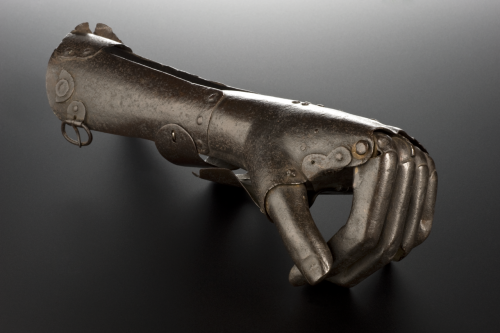http://www.sciencemuseum.org.uk/broughttolife/objects/display.aspx?id=92630

Mano izquierda Artificial y el antebrazo, Europa, 1501-1600: amputaciones quirúrgicas son referidos por Hipócrates. Ellos fueron durante muchos años una función principal del cirujano. Esta mano artificial data de los años 1500. La mayoría de los miembros fueron amputados en esta época debido a las heridas de guerra o accidentes. Se compone de una carcasa de metal. Esto envuelve alrededor del muñón del antebrazo y fue asegurado por correas de metal o de cuero. Una estructura mecánica interna (hoy desaparecidos) puede haber permitido a los dedos movimiento básico. Los dedos fueron creados como una masa sólida. Sin embargo, pueden flexionar en el más grande de junta articulada. Cirujano militar francés Ambroise Paré (1510-1590) adquirió experiencia como cirujano privado a los generales en el Ejército francés durante el año 1500. Sus libros sobre cirugía describen las nuevas operaciones y los tratamientos. Estos escritos describen sustitutos artificiales que ideó para sustituir miembros amputados. Algunos eran simples. Otros fueron elaborados dispositivos altamente mecanizadas que simulan el movimiento natural y la función de la extremidad.

Credits: Science Museum, London
Object number:
A634417
Artificial left hand and forearm, Europe, 1501-1600: Surgical amputations are referred to by Hippocrates. They were for many years a main function of the surgeon. This artificial hand dates from the 1500s. Most limbs were amputated in this era due to war injuries or accidents. It consists of a metal casing. This wrapped around the forearm stump and was secured by metal or leather straps. An internal mechanical structure (now missing) may have allowed the fingers basic movement. The fingers were created as a solid mass. However, they can flex at the largest knuckle joint. French military surgeon Ambroise Paré (1510-1590) gained experience as a private surgeon to generals in the French Army during the 1500s. His books on surgery described new operations and treatments. These writings describe artificial substitutes he devised to replace amputated limbs. Some were simple. Others were elaborate highly-mechanised devices that simulated the natural movement and function of the limb.







